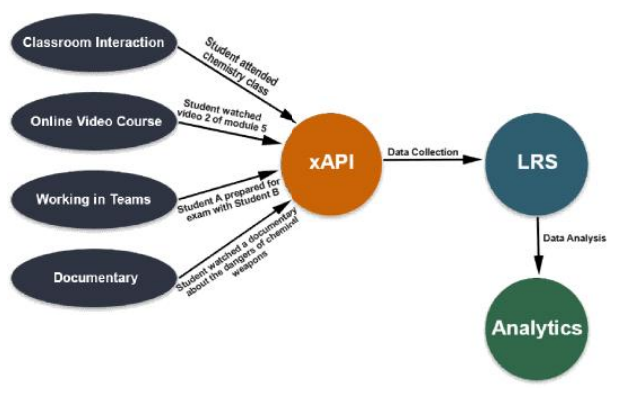Blended Learning and Tracking Offline Learning – The xAPI Way

As a training manager, I’m sure you are aware of the importance of tracking learner activities in a training program. Blended learning is all about combining online learning and traditional classroom learning. The online portion of the learning can obviously be tracked using a Learning Management System (LMS), but what about the learning activities that take place in the classroom?
What is xAPI?
A specification for learning technology that makes it possible to collect data about the wide range of experiences a person has (online and offline).
Think about it. How can the complete potential of blended learning be measured if the learning activities within the classroom are not tracked? Well, there is a way to track these offline activities too. This is where the Experience API (xAPI) comes in.
What is xAPI?
xAPI.com, the official website of Experience API, defines xAPI as “an eLearning specification that makes it possible to collect data about the wide range of experiences a person has within online and offline training activities”. Just like AICC and SCORM, xAPI is an eLearning standard that facilitates tracking, recording, and storing learners’ progress to measure training effectiveness.
xAPI was released in the year 2013, by Rustici Software as ADL, the keepers of SCORM, realized it was time to develop a standard for the next generation and worked along with Rustici Software to create one. Well, what was wrong with the older specification – SCORM – you ask?
How is xAPI Different from SCORM?
Yes, SCORM indeed is the most widely used eLearning standard, but unfortunately it fails to cater to one modern learning need – track learning that happens anywhere, anytime. Though SCORM allows tracking of learning that takes place in an LMS, it does not track learning that happens beyond the LMS.
But this is not the case with xAPI. xAPI allows you to track activities both online and offline, regardless of where the learning activity takes place. Also, any learning activity such as watching a YouTube video, can be tracked too. All that is required is an xAPI-enabled device and occasional Internet connectivity. No, xAPI does not require a constant Internet connection. Even if a learner is taking up the activity in the absence of Internet, the activity gets stored within the system and gets transferred when he/she is online.
Also, the tracking abilities of SCORM are merely restricted to the completion of modules or courses, the time taken, pass/fail in assessments, and the score. But with xAPI, tracking has received a wider scope.
Say, a learner starts watching a video on his/her desktop. xAPI records the time the learner began to watch the video. Now, if the learner pauses the video at a certain time to shift to a smartphone, this also gets recorded. Thus, detailed tracking can be provided by using xAPI.
But, How Does xAPI Track Offline Activities?
While SCORM allows the creation and publishing of courses within an LMS, xAPI is not just restricted to the LMS. Any software or system that is xAPI-compatible can be tracked using xAPI. So how are these learning activities, which take place in diverse environments, stored and tracked? This is where the LRS or the Learning Record Store comes in. The LRS can either be standalone, part of an LMS, or part of any other system.
A Learning Record Store is the heart of xAPI and stores all learning activities in the form of a specification called an ‘Activity Statements.’ To understand what an Activity Stream is, we need to look into the world’s most popular social networking site, Facebook. Remember those notifications you receive when somebody likes a post you shared? The notification states, ‘Justin liked your post’. These are Activity stream statements.
When a learner involves in an activity, for example, pauses a training video, an activity stream statement is sent to a Learning Record System (LRS) stating ‘X paused the video’. Thus, every single activity of a learner is tracked, recorded, and stored within an LRS.

Source: www.researchgate.net
Why Use xAPI for Blended Learning?
- Track beyond online learning
- Motivate employees to pursue diverse activities
- Implement better training
- Enhance learning experience
Why Use xAPI for Blended learning?
Facilitate Tracking Beyond Online Learning
Often, the learning activities that happen within a classroom cannot be tracked, which leads to an inaccurate measurement of training effectiveness. But by integrating xAPI into your system, both the activities happening within eLearning courses and classroom learning activities can be tracked. Let us look into how a few activities can be tracked:
- Did your employee just read a book as part of training? Downloading the book scanner app allows the learner to scan the barcode on the book and record it as a learning experience.
- Are you planning to hold a conference session for your learners? Incorporate a conference registration system to prepare xAPI statements to keep track of the number of learners attending.
- Did you ask your learners to watch a video on YouTube? Utilize the xAPI bookmarklet that puts an ‘I Learned This’ button on your learners’ browsers which allows them to record any webpage as an experience into the LRS.
Motivate Employee to Pursue Diverse Activities
You might have noticed that your learners might not be as motivated to participate in offline activities as much as they are motivated to participate in online activities. This is because, it’s human nature to put in our best when we know we are being noted or appreciated for our work. In case of blended learning, since most offline activities are not tracked, learners are not motivated to take them up. But integrating your offline activities with xAPI can eradicate this too.
Let us take the example of a learner taking up CPR training. After the completion of the course, the learner had performed CPR on a training dummy. This is indeed a very vital part of training and if not tracked how the learner is performing, the effectiveness of training cannot be measured. But xAPI lets you measure this too. Check how the activity is tracked by xAPI, here.
Another example could be of reading a book. Reading a book as part of training is definitely something your learners might cringe from. But once they are aware that it will be tracked and stored as part of their overall learning event, they will definitely be motivated to read.
Thus, training effectiveness can be holistically measured, and learners will be motivated to perform better even in offline learning activities as they are being monitored and tracked.
Implement Better Training
By tracking every single learning activity your learners take up, you are gaining access to extremely valuable insights. You are gaining access to how exactly each learner interacted with the learning materials you provided. You will know how much time they spent on a particular activity and which device they preferred using the most.
Such details will further allow you to understand the type of learning material your learners prefer. Once you are aware of this, you can devote your time and effort to build a training program that caters to the needs of your learners, increasing the overall training efficiency.
Enhance the Learning Experience
SCORM was the most widely used eLearning standard over the years. But the limitations that came along with it put a restriction on harnessing the complete potential of learning strategies. Since xAPI has very few limitations and allows tracking of offline activities, various new strategies can be incorporated into your training framework.
For example, the various features of mobile devices such as Camera, GPS, Compass etc., can be incorporated into training. Learners can be encouraged to have productive discussions on social media etc. Thus, interesting and creative ways to deliver training can be thought of when integrating xAPI into your training framework.
Summing it Up!
Keeping up with evolving tech is important and xAPI is definitely something every organization should look forward to and embrace without a doubt. But before jumping onto the xAPI bandwagon, keep in mind that it is still a young and evolving trend. There is much more to having an effective blended learning design than simply integrating a learning activity tracking system. Get better insights about blended learning by downloading our eBook.





![Can Blended Learning Fix Your Boring Training Programs? [Answered]](https://blog.commlabindia.com/hubfs/blogs/blended-learning-creating-engaging-training-experiences.jpg)